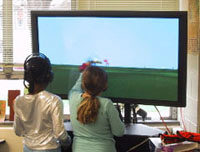First-Person Science Inquiry in Virtual Ambient Environments
March 31st, 2001
Categories: Devices, Education, Tele-Immersion

Authors
Moher, T., Johnson, A., Cho, Y.About
Virtual ambients are a class of restricted simulations designed to support science inquiry learning among elementary school students. Virtual ambients employ large multi-user displays to support “first-person” collaborative exploration, data collection, and the construction of support for hypotheses in simulated environments. In order to reduce the cognitive load on learners, navigation - in space, time, and scale - is used instead of traditional learning simulations’ direct control of independent model variables. Early experience with elementary school students at three grade levels is reported, employing a configurable virtual ambient named “the Field”.
Elementary school science is about asking questions, collecting data that bear on those questions, and building support for answers. For the past year, we have been developing instructional interventions which employ virtual ambients - simulated natural and synthetic environments - as loci for children’s scientific exploration. Virtual ambients are three-dimensional “first person” spaces where users navigate in space, scale, and time, implemen-ted on multi-user projective (stereoscopic) displays for use by groups of 2-4 students. Virtual ambients may include simulated scientific instrumentation, and may provide users with “bread crumbs” as navigation and data collection aids.
Virtual ambients may be static or dynamic, but unlike traditional simulations, they offer users no direct control over independent variables. This constraint is designed to reduce the cognitive burden of exploring complex input spaces [1, 2, 3] by limiting young learners to familiar concepts and activities: moving around, seeing things at different scales, and imagining the past and future. It does not preclude the articulation and investigation of causal hypotheses; it simply shifts the burden from artificially manipulating preconditions to finding instances of varying preconditions in space or time.
Virtual ambients provide young learners access to phenomena which might otherwise be inaccessible, while at the same time allowing educators to scaffold learning by controlling the complexity of the simulated world. We are investigating the hypothesis that working in virtual ambients - planning, navigating, observing, collecting and describing data - facilitates both the learning of both scientific investigation skills and specific math and science content learning.
Resources
URL
Citation
Moher, T., Johnson, A., Cho, Y., First-Person Science Inquiry in Virtual Ambient Environments, ACM Conference on Human Factors in Computing Systems (CHI 2001), Seattle, WA, pp. 261-262, March 31st, 2001. http://www.evl.uic.edu/aej/papers/chi2001.htm